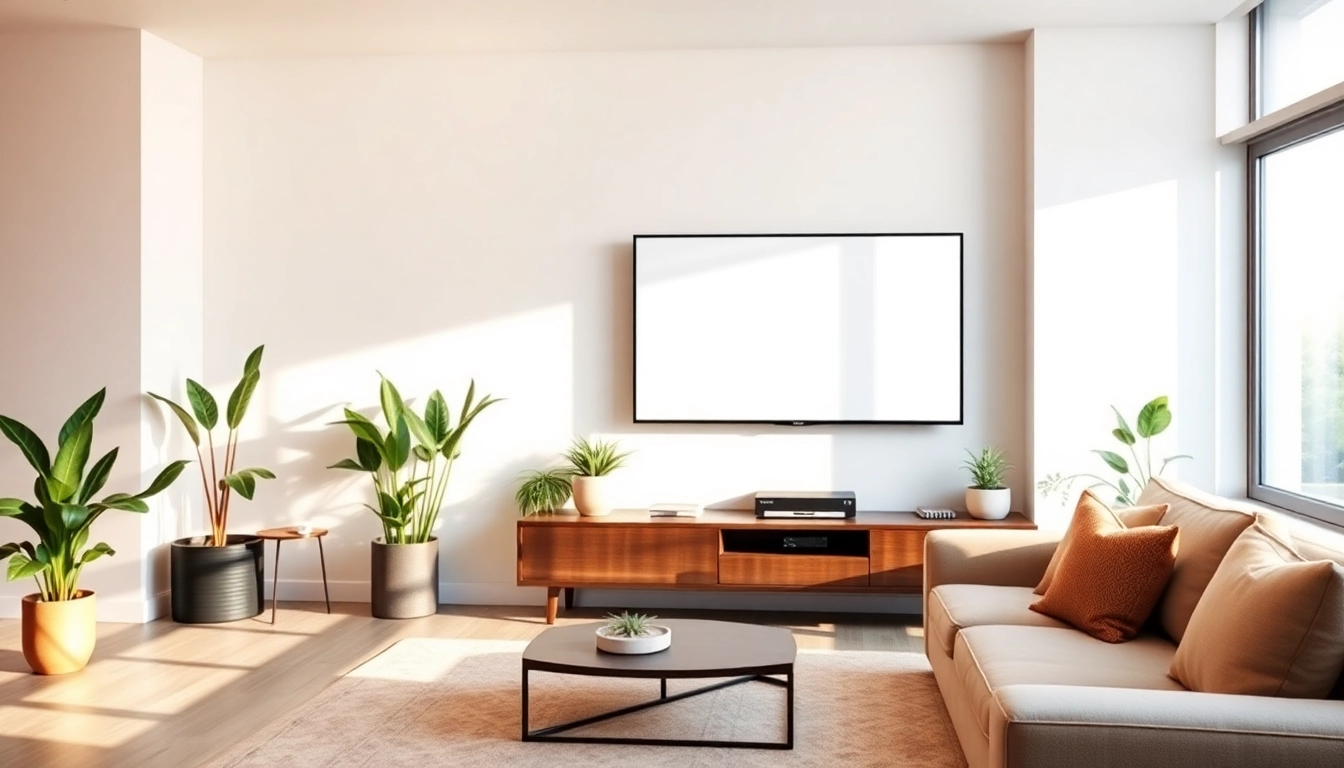Understanding TV Mounting Installation Services
What is TV Mounting?
TV mounting is the process of securely attaching a television to a wall, creating an aesthetically pleasing display and saving valuable floor space. This service typically involves the use of a mount that can either be fixed, tilting, or fully articulating, depending on the viewer’s needs and preferences. Proper installation guarantees safety, minimizes the risk of falling screens, and enhances the viewer’s enjoyment and comfort.
Benefits of Professional Installation
While DIY options exist, professional TV mounting installation services offer numerous benefits:
- Expertise: Professionals possess the technical knowledge and experience required to mount TVs securely. They are well-versed in various mount types and wall materials, ensuring a safe and reliable installation.
- Time-Saving: Hiring a professional saves time and effort, allowing homeowners to focus on other aspects of their home entertainment without the hassle of setup.
- Safety: A well-mounted TV minimizes the risk of accidents. Professionals use proper tools and techniques to secure the television safely away from children and pets.
- Warranty: Many professional services offer warranties on their installation, providing peace of mind should any issues arise post-installation.
Types of TV Mounts Available
Understanding the different types of TV mounts is crucial in selecting the best option for your space:
- Fixed Mounts: These mounts hold the TV flat against the wall and are ideal for viewing at a fixed angle.
- Tilting Mounts: Allow the TV to tilt downward, which is beneficial for high wall placements.
- Full-Motion Mounts: These offer the most flexibility, allowing the TV to extend, swivel, and tilt, making them perfect for corner placements or multiple viewing angles.
Cost Factors for TV Mounting Installation Service
Average Pricing Overview
The cost of a TV mounting installation service can vary significantly depending on several factors. On average, homeowners can expect to pay between $100 and $300 for professional services. Here’s a breakdown:
- Small TVs (32”-41”): $60 to $120
- Medium TVs (42”-49”): $80 to $150
- Large TVs (50”-64”): $100 to $200
- Very Large TVs (65” and above): $120 to $300
These figures can fluctuate based on regional pricing and local demand.
Additional Charges Explained
In addition to base prices, several factors may incur additional charges, including:
- Wall Type: Mounting on brick or concrete walls may require special tools, increasing costs.
- Complex Wiring: Concealing cables within walls and adding extra outlets can lead to higher expenses.
- Mount Purchase: If you require a specific mount that isn’t provided, costs for the mount itself may be extra.
How to Estimate Your Costs
To estimate your total costs accurately, consider the following steps:
- Determine the size and type of your TV to identify the appropriate mounting service cost.
- Assess the wall material where the TV will be mounted to anticipate any additional requirements.
- Choose a mounting service that provides a clear breakdown of costs upfront, helping you avoid surprises.
Choosing the Right Service Provider
What to Look For in a TV Mounting Service
Selecting the right TV mounting service provider requires careful consideration. Look for the following indicators:
- Experience: A track record of successful installations can denote reliability.
- Certification: Verify that technicians are certified to perform electrical and structural work.
- Insurance: Ensure the provider is insured to protect you from liabilities in case of accidents.
Customer Reviews and Ratings
Checking customer feedback is a great way to assess service quality:
- Look for patterns in reviews. Repeated praise or criticism can be revealing.
- Utilize platforms like Google Reviews or Yelp to gather unbiased opinions from customers.
- Seek testimonials on the company’s website and third-party review sites for a broader perspective.
Questions to Ask Before Hiring
Before finalizing a service provider, consider asking the following questions:
- What is included in the installation cost?
- How long will the installation take?
- Do you provide warranty coverage for your work?
DIY vs. Professional TV Mounting Installation
Pros and Cons of DIY Installation
Many homeowners contemplate a DIY approach. Here are the pros and cons:
- Pros:
- Cost Savings: Avoid paying for labor by doing it yourself.
- Flexibility: Complete the job on your own schedule.
- Cons:
- Skill Requirements: Lacking experience can lead to improper installation, risking damage.
- No Warranty: DIY jobs usually lack professional warranty protections.
When to Hire a Professional
Consider hiring a professional under these circumstances:
- When dealing with heavy or oversized TVs that require specialized mounting.
- For complicated installations involving multiple devices and wiring.
- If you lack confidence in your ability to install securely.
Safety Considerations
Always prioritize safety for DIY installations. Use the following guidelines:
- Ensure wall studs are located and utilized for mounting.
- Double-check tools and materials to avoid accidents.
- Consider the weight of the TV and the capacity of your mounting hardware.
Tips for a Successful TV Setup
Ideal Wall Placement Guidelines
To maximize viewing pleasure, observe these placement tips:
- Mount the TV at eye level when seated for optimal comfort.
- Maintain a distance of 1.5 to 2.5 times the diagonal size of the TV for the best viewing experience.
- Avoid direct sunlight to reduce glare on the screen surface.
Hiding Cables and Wires
Hide unsightly cables and wires for a cleaner look:
- Use cable management systems or Raceways, which can be painted to match the walls.
- Consider in-wall cable management solutions for a flawless aesthetic.
- Employ Velcro straps and clips to bundle cables neatly.
Achieving the Best Viewing Angle
Adjusting the viewing angle can be crucial for aligning the television appropriately:
- Consider the location of windows and light sources that might create reflections.
- Install tilting mounts to adjust the viewing angle as necessary, especially for TVs mounted high on the wall.
- If using a full-motion mount, experiment with position settings before securing the mount completely.
